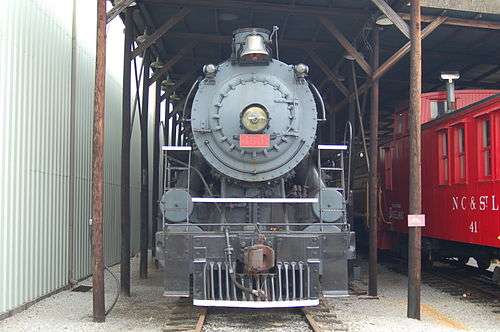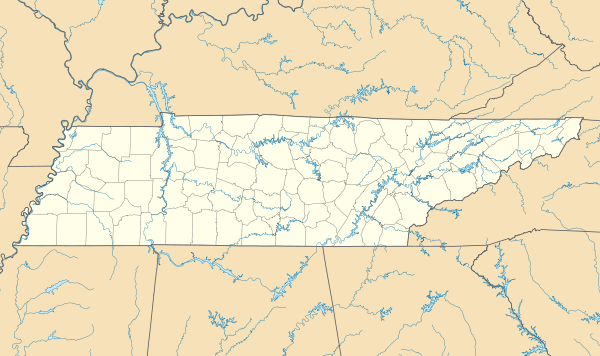Tennessee Valley Railroad Museum
 Southern Railway 4501, one of six steam locomotives at the museum. | |
 Location of TVRM within Tennessee | |
| Established | 1960 |
|---|---|
| Location |
4119 Cromwell Rd. Chattanooga, Tennessee, United States |
| Coordinates | 35°04′00″N 85°12′23″W / 35.066667°N 85.206389°W |
| President | Tim Andrews |
| Website |
www |
The Tennessee Valley Railroad Museum (reporting mark TVRM)[1] is a railroad museum in Chattanooga, Tennessee.
The Tennessee Valley Railroad Museum was founded as a chapter of the National Railway Historical Society in 1960 by Paul H. Merriman and Robert M. Soule, Jr., along with a group of local railway preservationists who were concerned with saving steam locomotives and railway equipment for future historical display and use.
History
Founded in 1960 and incorporated in 1961, the Tennessee Valley Railroad Museum originally stored equipment at the Western Union pole yard which was located adjacent to the Southern Railway classification yard on Holtzclaw Avenue in East Chattanooga. After the termination of passenger service to the Southern Railway's Terminal Station in 1971, additional cars and locomotives were stored at this facility in downtown Chattanooga. In 1969, the TVRM received a land donation from the Southern Railway consisting of a property located in East Chattanooga on North Chamberlain Avenue. This donation also included the 986-foot (301 m)-long Whiteside Tunnel and about 1½ miles (2.4 km) of abandoned right-of-way.
In 1970, the museum opened a new permanent facility in East Chattanooga to the public. At the time of its opening, there were no structures on site, although volunteers had constructed a railyard for the storage and repair of equipment and had rebuilt the abandoned rail line through the Whiteside Tunnel. The reconstructed line ended at Tunnel Boulevard as the original bridge over this road had been removed some years earlier.
With the reconstructed rail line, the museum had the ability to produce a small amount of income operating a heritage railroad by running passenger excursion trains through Whiteside Tunnel (commonly referred to as Missionary Ridge Tunnel).
Additional income was derived from mainline excursions operated biannually via the Southern Railway's Steam Program. The birth of the Southern Railway's Steam Program was brought about by Paul Merriman and TVRM, when, in 1964, Merriman purchased the former Southern Railway 4501 from the K&T Railroad in Stearns, Kentucky for $5,000. The program began in 1966 when the freshly restored 4501 emerged from a 2 years long restoration which had been done at Lucey Boiler Company in Chattanooga. After many volunteer hours by TVRM members as well as paid Lucey Boiler employee work, the 4501 began roaming all over the Southern Railway System delighting onlookers and passengers everywhere.
After years of hard work and much financial discipline, in 1977 TVRM finally built the long needed bridge over Tunnel Boulevard. The Southern Railway then donated an additional mile and a half (2.4 km) of abandoned rail line. The next major task undertaken was to build the East Chattanooga Depot. This depot is a reconstruction of a typical small town depot of the 1920s. The 1980s saw TVRM named to the National Register of Historic Places on August 6, 1980, expansion of the organization, and more land donated by Southern Railway. During the 1980s, more track and buildings were gradually added. The Grand Junction Depot, the TVRM Administration Building, and the National Model Railroad Association were starting to take shape during the decade, as well. At the East Chattanooga facility, a repair shop and a turntable were added to provide facilities for locomotive repair and maintenance. Beginning in the 1990s, TVRM started running trains to the Chattanooga Choo Choo (called the Downtown Arrow, now discontinued) and excursions down to Summerville, Georgia on the Chattooga and Chickamauga Railway.
In 2004, TVRM and the Tennessee Overhill Heritage Association partnered up in acquiring part of the former L&N Hook and Eye line between Etowah, Tennessee (Gee Creek, Tennessee) and Copperhill, Tennessee. Since then, despite skipping the 2005 season, the new Hiwassee River Rail Adventures have been a popular addition to the railroad. With the success of the Hiwassee trips, TVRM split into two distinct operating divisions: the Chattanooga and Hiwassee Divisions, though crews and sometimes equipment often switch between the two.
The museum celebrated 50 years during the Labor Day weekend of 2011. Norfolk Southern Railway also debuted their new steam train program during the event.[2]
Current operations
Today, TVRM continues to run trains, showing people what it was like in the golden age of railroading, and has started local freight service. Visitors can also take a one-hour 6-mile (9.7 km) round-trip ride, which is typically pulled by a steam locomotive.
In 2004, TVRM began providing half-day excursion trains to the Hiwassee Loop, a corkscrew tunnel through which the train passes near Farner, Tennessee. These trips run out of the station in downtown Etowah, Tennessee (about an hour's drive (63 miles (101 km)) northeast of Chattanooga), but since it is along the main CSX mainline heavily used for freight, a bus takes travelers a short ride south to Hiwassee/Ocoee Scenic River State Park to transfer. The 50-mile (80 km) excursion goes east along the Hiwassee River and through the Hiwassee Gorge to Farner, just short of the North Carolina state line. Full-day trips turn south, ending at lunchtime in the twin towns of Copperhill, Tennessee and McCaysville, Georgia, and then returning in the afternoon. This route is that of the former Atlanta, Knoxville and Northern Railway and is also called the Hiwassee Route. The remainder of the AK&N (later L&N and then CSX) line in Georgia is operated by the Georgia Northeastern Railroad, with subsidiary Blue Ridge Scenic Railway operating another heritage railroad from McCaysville to Blue Ridge, Georgia, and GNRR freight running south of there.
TVRM also handles freight. On TVRM's Chattanooga Division, there is one industry, Allied Metals. TVRM also handles switching operations, under the wholly owned subsidiary Tyner Terminal Railway Company,[3] at Enterprise South Industrial Park (ESIP), location of the Volkswagen Chattanooga Assembly Plant. Even though there are no major industries along the Hiwassee Division, TVRM has the capability to store several hundred cars at the Copperhill yard for other railroads.
Restoration work
TVRM has a full working locomotive and car repair shop complex, Soule Shops (named after co-founder, Robert M. Soule, Jr.), capable of handling even the heaviest repairs. In March 2011, TVRM completed restoring Southern Railway Ks-1 class 2-8-0 630 to operational status. In September 2014, TVRM completed the second restoration of Southern Railway Ms-1 class 2-8-2 4501 for another excursion career with Norfolk Southern's 21st Century Steam Excursion Program. At present, one locomotive is under restoration to operational status: Southern Railway E8A 6914. 630's 10-year-long restoration was the most extensive restoration ever performed at TVRM, as well as one of the most extensive steam locomotive repairs in the United States since the end of steam on the railroads.
TVRM in the movies
TVRM has been a prime movie spot since the early 1970s. Several of the rail cars that TVRM owns have been used in movies, i.e. the collection holds the Pullman sleeping car "Clover Colony" that was used in the Marilyn Monroe movie Some Like it Hot, which was filmed in 1959, two years before TVRM started.
A partial list of movies shot with TVRM equipment follows:[4]
- Fool's Parade (1971) (Southern 4501 as B&O 4501)
- Eleanor & Franklin (1976), starring Jane Alexander and Edward Herrmann
- The Last Days of Frank and Jesse James (1986)
- Fled (1996) (shot on the TVRM mainline)
- Mama Flora's Family (1998)
- October Sky (1999) (Southern 4501 appearing as N&W 4501 with O. Winston Link being the engineer)
- The Adventures of Ociee Nash (2003)
- Warm Springs (2005) (shot in Summerville, Georgia, using TVRM equipment)
- Heaven's Fall (2007)
- Leatherheads (2008), starring George Clooney and Renée Zellweger
- Water for Elephants (2011), starring Reese Witherspoon and Robert Pattinson
- The music video for Josh Turner's 2003 country music hit single "Long Black Train" was shot on TVRM property as well.[4][5][6][7][8][9][10][11][12][13][14][15]
- 42 (film) (2013), starring Chadwick Boseman and Harrison Ford Jackie Robinson leaves for the Montreal Royals, a minor league single-A division club under the ownership of the Brooklyn Dodgers, from the Tennessee Valley Railroad Museum's main station. Southern 630 also made an appearance in this movie but with a different number.
See also
References
- ↑ Railinc, Search MARKs, accessed September 2009
- ↑ "'21st Century Steam' Launches Labor Day Weekend". PR Newswire. August 19, 2011. Retrieved 29 August 2012.
- ↑ Smoke & Cinders, Quarterly Publication of TVRM, Vol. 52, No. 2, 2nd Qtr, 2013, Page 1 (ISSN 1083-1606)
- 1 2 "In the Movies". Tennessee Valley Railroad Museum. Retrieved 28 August 2012.
- ↑ Fool's Parade at the Internet Movie Database
- ↑ Eleanor & Franklin at the Internet Movie Database
- ↑ Last Days of Frank and Jesse James at the Internet Movie Database
- ↑ Fled at the Internet Movie Database
- ↑ Mama Flora's Family at the Internet Movie Database
- ↑ October Sky at the Internet Movie Database
- ↑ The Adventures of Ociee Nash at the Internet Movie Database
- ↑ Warm Springs at the Internet Movie Database
- ↑ Heaven's Fall at the Internet Movie Database
- ↑ Leatherheads at the Internet Movie Database
- ↑ Water for Elephants at the Internet Movie Database
External links
| Wikimedia Commons has media related to Tennessee Valley Railroad Museum. |
- Tennessee Valley Railroad Museum
- Additional information about TVRM and co-founder Robert M. Soule
- The 21st Century Steam Project by Norfolk Southern and TVRM